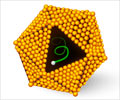Rare cancer type viewed to derive from cells in the bile ducts of the liver might in fact build up when one type of liver cell morphs into an entirely different type.

The two cell types, hepatocytes and biliary cells, exist side by side in the liver, but don't normally change their "stripes" -- their cellular function -- let alone turn into each other. Scientists have therefore assumed that hepatocellular carcinomas, the most common kind of liver cancer, start in the hepatocytes and that cholangiocarcinomas, the bile duct cancers, start in the biliary cells.
Hepatocytes, which form the bulk of the liver, "are very good at making other hepatocytes," said Holger Willenbring, PhD, an associate professor of surgery, a member of the Eli and Edythe Broad Center of Regeneration Medicine and Stem Cell Research at UCSF, and a senior author of the study. "They can divide many times but are restricted in the progeny they produce. They either produce more hepatocytes or, if something goes wrong, can cause hepatocellular carcinomas."
The study started when Xin Chen, PhD, an assistant professor of bioengineering and therapeutic sciences and a senior author of the manuscript, tried to make something go wrong in the hepatocytes as a way to explore the origins of hepatocellular carcinoma. Chen and her group hoped to induce the cancer in mice by activating oncogenes, genes that trigger cancer.
Things did go awry in the hepatocytes -- but not in the way the researchers expected. In specific conditions, mice developed cholangiocarcinoma instead of hepatocellular carcinoma. "We were very surprised," Chen recalls. They asked, "How did that happen?"
The two scientists figured some of the genes they had activated might have reprogrammed the hepatocytes in a way that turned them into aberrant biliary cells, capable of forming tumors. Their chief suspects were two genes, NOTCH, which is known to be involved in the embryonic development of bile ducts, and AKT, which has been shown to play a role in many tumors.
Advertisement
Willenbring's lab had previously developed a method for labeling mouse hepatocytes so that they, and any cell they turned into, would glow. They put this "hepatocyte fate-tracing" system to work and were able to show that the cancerous cells that formed bile duct tumors had in fact started out as hepatocytes.
Advertisement
"This highlights how readily one cell can be converted into another and how cancer can do it for you very efficiently," Willenbring said. "For us, it's fairly shocking. It only took two oncogenes and it all happened in a few weeks."
The findings also help explain another puzzle: why the incidence of bile duct cancer is higher in people with hepatitis. "Since hepatitis doesn't do anything to biliary cells that didn't quite make sense," Willenbring said
Now there's a new way to look at it, he suggests. As hepatocytes and their genomes become disarrayed by disease, Willenbring says, they may activate oncogenes in much the same way their experiment did, causing the cells to change identity and become cancerous.
Having shown that NOTCH and AKT are the triggers in this tumor-inducing process, Chen and her team are now hunting for therapies. Working with colleagues from Genentech Inc., they are testing antibodies that may blunt the activity of the genes and halt or reverse the growth of bile duct cancers in mice. "The preliminary results with the therapeutic antibodies are very encouraging," Chen says. If they find the right formula, they may have an answer for a currently untreatable cancer.
Source-Eurekalert















